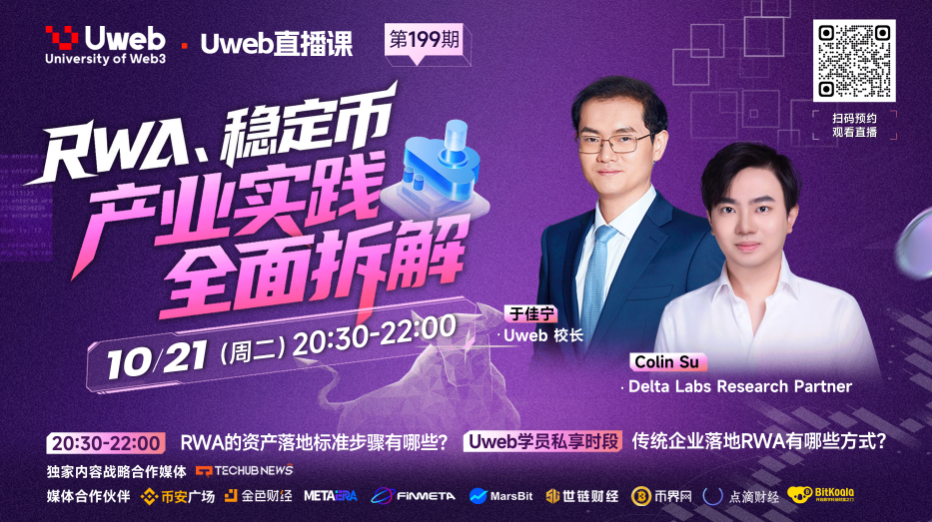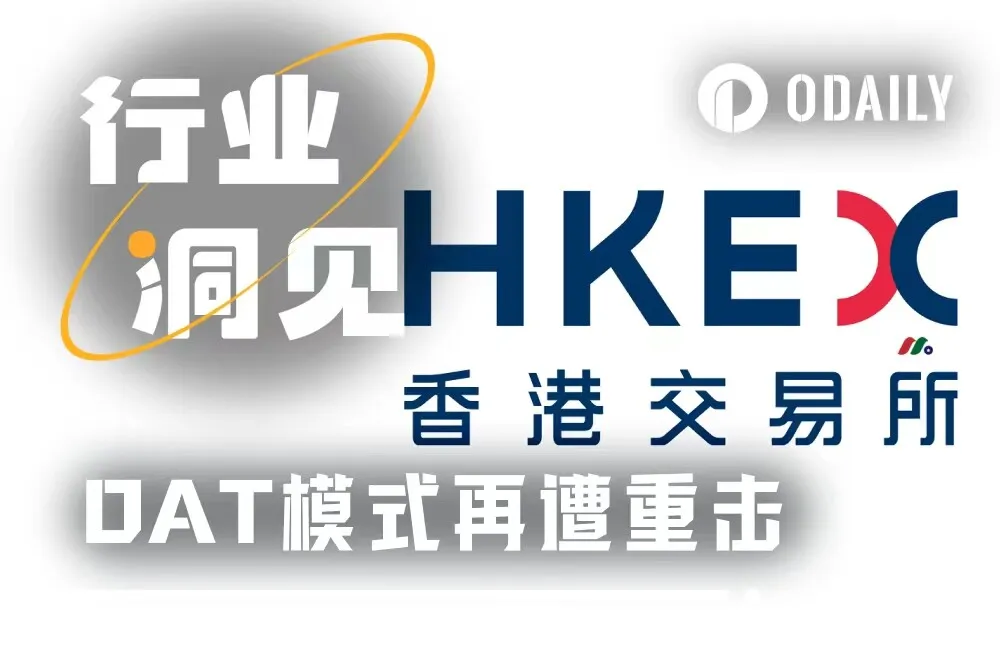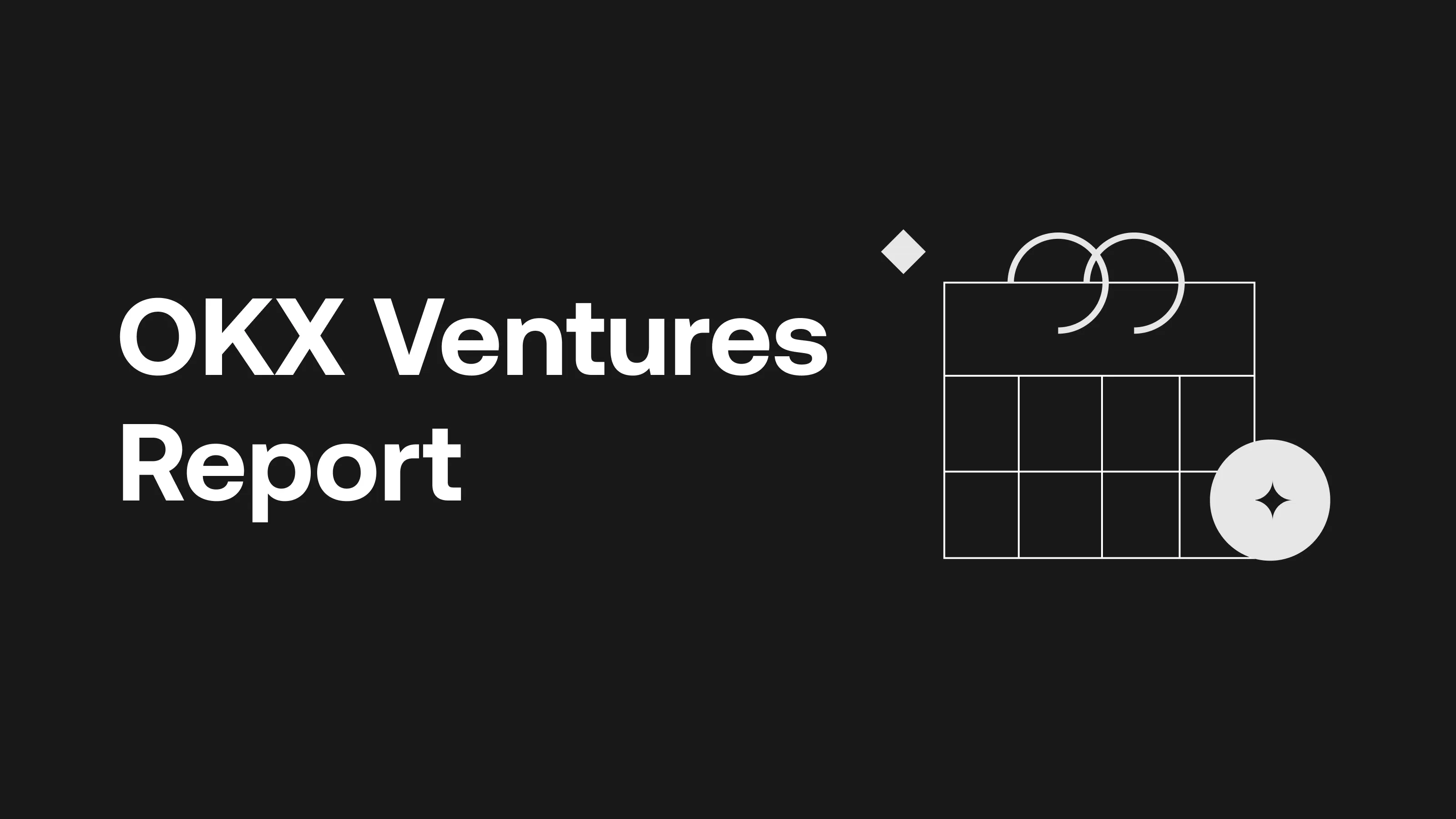In 2025, RWA (Real World Asset Tokenization) and stablecoins continue to be focal topics in the Web3 space. On the evening of October 21 at 20:30, the 199th episode of Uweb's live broadcast kicked off as scheduled, with Uweb President Yu Jianing as the host, inviting Colin Su, a research partner at Delta Labs, to the live studio for an in-depth dialogue on "Comprehensive Dissection of RWA and Stablecoin Industry Practices." The discussion covered industry structure, asset landing priorities, and the impact of the stablecoin market, providing viewers with a knowledge-sharing session that combined professionalism and practicality, attracting over 400 industry enthusiasts to participate.

Core Focus One: Detailed Explanation of RWA Industry Structure — From Participants to Core Challenges
During the live broadcast, Colin Su first systematically dissected the RWA industry structure, clarifying its core participants and functional divisions, thereby building a clear industry cognitive framework for the audience.
1. Four Core Participants Building the RWA Ecosystem Foundation
Colin pointed out that the RWA industry mainly consists of four types of roles, each interconnected, collectively promoting the on-chain process of real assets:
Asset Issuers: Responsible for converting real assets such as bonds, gold, and real estate into on-chain tradable tokens, undertaking core functions of compliance structure design, revenue distribution, and asset custody. For example, Backed Finance, which issues tokenized stocks, Realty, focusing on U.S. real estate RWA, and Matrix Stock, which specializes in tokenizing U.S. short-term government bonds, all fall into this category.
Infrastructure Providers: Serving as the "underlying support" of the RWA ecosystem, they provide asset issuance tools, KYC identity verification, compliance support, and custody services, often collaborating with public chains, permissioned chains, and compliant issuance platforms, such as Polymesh, Securities, and some commercial banks' Layer 1 solutions.
Application Layer Platforms: Connecting end-users with on-chain RWA assets, providing entry points for portfolio management, some of which integrate with DeFi protocols. Examples include on-chain lending platforms like Maple Finance and Serap, as well as Centrefuge and Goldfinch, which focus on accounts receivable and commercial paper, representing typical application layer entities.
Data and Oracle Service Providers: Acting as a "bridge" between on-chain and off-chain, they provide key data such as price indices and interest rate references for tokens. Mainstream oracles like Chainlink, Tolkony, and Redstone play important roles in this segment, with Tolkony also offering compliance identity QIC module support.
2. Three Core Challenges: Legal, Operational, and Rights Confirmation Realities
After dissecting the structure, Colin also confronted the pain points of RWA implementation, emphasizing that its core challenges are not technical but concentrated in the areas of law, operations, and asset rights confirmation:
Ambiguity in Rights Confirmation: Some RWA projects have weak legal foundations, and token holders often only possess "digital certificates" rather than complete ownership of the underlying assets. For instance, project parties may not legally hold the corresponding assets, or the assets may have been pledged, making it difficult to protect investors' rights.
Unclear Responsible Parties: Taking real estate RWA as an example, there have been projects where shell companies held real estate assets, and when conflicts of interest arose between tenants and token holders, the question of "who is responsible" lacked a clear answer, exposing gaps in operational responsibilities.
Irreplaceable Off-Chain Operations: Even with blockchain enabling functions like rent payments and rights distribution, basic tasks such as property tax payments and daily maintenance still require off-chain teams to execute. If off-chain government land registrations do not recognize on-chain token rights, the ultimate reliance will still be on physical laws, highlighting the reality that "code cannot completely replace law and human effort."
Core Focus Two: RWA Asset Landing Priority Order — Path Differences Between the U.S. and Hong Kong
When discussing the landing priorities of RWA assets, Yu Jianing and Colin focused on comparing the differentiated paths of the U.S. and Hong Kong, revealing the choices formed by differences in market maturity and policy orientation.
1. United States: Starting with Standardized Assets, Pursuing Efficiency Improvements
As a global RWA pioneer, the U.S. has chosen standardized financial assets as its core landing direction, covering four major categories: equity, fixed income, commodities, and foreign exchange:
In equity assets, decentralized exchanges for U.S. stocks (like X Stocks) and the on-chaining of pre-IPO unicorn companies are hot topics, with a preference for testing high-certainty unicorn companies rather than fully opening the primary market for equity on-chain;
In the fixed income sector, U.S. Treasury bonds and related financial products have formed a rich matrix of RWA products, with private credit occupying $16 billion of the current $28 billion RWA market, becoming a mainstream direction, with leading PE firms like Blackstone and KKR focusing on this area;
In commodities, gold (PAXG, XAUT) accounts for over 80% of the market share, with potential future expansions into silver, agricultural products, and black assets;
On the foreign exchange front, stablecoins are the primary form, with USDT and USDC essentially being on-chain expressions of fiat currency.
Colin emphasized that the U.S. logic is to "move existing high-quality, fully priced assets on-chain," enhancing traditional financial efficiency through blockchain — for example, a certain BlackRock fund used blockchain to shorten the redemption cycle from T+1 to real-time, reducing transaction costs by 40%.
2. Hong Kong: Exploring Non-Standard Assets, Relying on Mainland Resources for Pilots
In contrast to the U.S., Hong Kong's current RWA practices lean more towards non-standard assets, such as new energy infrastructure, commercial real estate, and computing power assets, driven by both policy pilot considerations and unique advantages of relying on mainland assets:
On the policy level, Hong Kong, as a financial "sandbox" for the mainland, needs to explore paths first before feeding back to the mainland. Standardized assets, due to the need for multi-department coordination and clear responsibility attribution, are less frequently touched; non-standard assets, with greater regulatory flexibility, have become a "testing ground" for entrepreneurs and institutions;
On the case level, Longxin Group tokenized charging piles and battery assets to raise $100 million, a certain office building in Causeway Bay was split into 1 million tokens corresponding to property rights and income rights, and GCL-Poly's photovoltaic power station achieved income rights splitting through Hong Kong's green finance sandbox pilot, all representing typical practices of non-standard asset RWA in Hong Kong;
Looking ahead, Colin predicts that Hong Kong stocks may become the "explosion point" for RWA in Hong Kong — the Hong Kong Stock Exchange has been actively attracting global capital in recent years and has already established an internal blockchain system to address the settlement cycle differences of the Shanghai-Hong Kong and Shenzhen-Hong Kong Stock Connects, laying the foundation for stock tokenization. If policies promote this, Hong Kong stock RWA is expected to become a compliant demonstration case.
Core Focus Three: Market Impact of the Stablecoin War — Uncertain Landscape, Opportunities and Challenges Coexist
In addition to RWA, stablecoins, as the "on-chain form" of fiat currency, have also become a key topic of discussion in the live broadcast regarding market competition and industry impact. Colin analyzed the competitive landscape and potential impacts of the stablecoin sector using global examples.
1. Intensifying Competition: From "Dual Oligopoly" to "Multiple Types Coexisting"
Currently, while the stablecoin market is dominated by USDT and USDC, Colin believes that a "stronger becomes stronger + segmented field leaders" multi-polar pattern will form in the future:
Functional differentiation: In addition to traditional fiat-pegged stablecoins (like USDT, USDC), functional stablecoins such as payment types (PYUSD), yield-bearing types (USDM), synthetic types (USDE), and bank deposit types (JPM Coin) will emerge, covering segmented scenarios like online shopping, cross-border payments, wealth management, and trade financing;
Regional differentiation: Policy barriers will give rise to regional leaders, for example, regions like Hong Kong, the mainland, Singapore, and Dubai may form their own local stablecoin leaders due to regulatory differences;
Entry of giants: Super apps with traffic advantages (like WeChat, Alipay, Facebook) entering the stablecoin space could rewrite the market landscape by leveraging default payment entry points and user bases, potentially recreating a dual oligopoly similar to the mobile payment field of "Alipay + WeChat."
2. Real Value: From Anti-Inflation Tools to Inclusive Finance
Colin showcased the real value of stablecoins that have already landed through cases from Africa, Latin America, and Hong Kong:
In countries with high inflation like Nigeria and Zimbabwe, stablecoins have become a "necessity against inflation," with daily grocery shopping, salary settlements, and cross-border transfers all using USDT through platforms like Binance, and in some countries, "governments prohibit but the public still widely uses" them;
Filipino domestic workers in Hong Kong use stablecoins to remit money back to the Philippines, avoiding traditional banks' double fees, highlighting their cost advantages in cross-border payments;
These cases prove that stablecoins are not "speculative tools," but solutions to real financial pain points — in regions lacking mobile payment infrastructure, they directly allow users to "jump from the mobile payment era into the stablecoin era," achieving borderless dollar savings and consumption.
3. Potential Impact: Challenges to the Traditional Financial System
When discussing the impact of stablecoins on traditional finance, Colin also objectively pointed out their potential impacts: if fully promoted domestically, it could lead to a shrinkage in the scale of bank credit, custody, and wealth management businesses, and even trigger a wave of unemployment — for example, stablecoins bypassing bank credit approvals could reduce the demand for risk control and credit positions; self-custody models could weaken banks' custody businesses, affecting management fee income. This is also a significant reason for the current cautious attitude towards stablecoins in the domestic market.
End of the Live Broadcast: Industry Outlook and Subsequent Participation Channels
At the end of the live broadcast, President Yu Jianing summarized the core value of this sharing and provided the audience with ongoing learning channels. He mentioned that RWA and stablecoins, as key tracks connecting traditional finance and Web3, will continue to unleash potential in the future, and Uweb will provide more learning opportunities for industry enthusiasts through three live broadcasts each week (Tuesday for new track interpretations, Thursday for institutional-level business meetings, and Sunday for on-chain data interpretations), offline events, and courses.
免责声明:本文章仅代表作者个人观点,不代表本平台的立场和观点。本文章仅供信息分享,不构成对任何人的任何投资建议。用户与作者之间的任何争议,与本平台无关。如网页中刊载的文章或图片涉及侵权,请提供相关的权利证明和身份证明发送邮件到support@aicoin.com,本平台相关工作人员将会进行核查。




